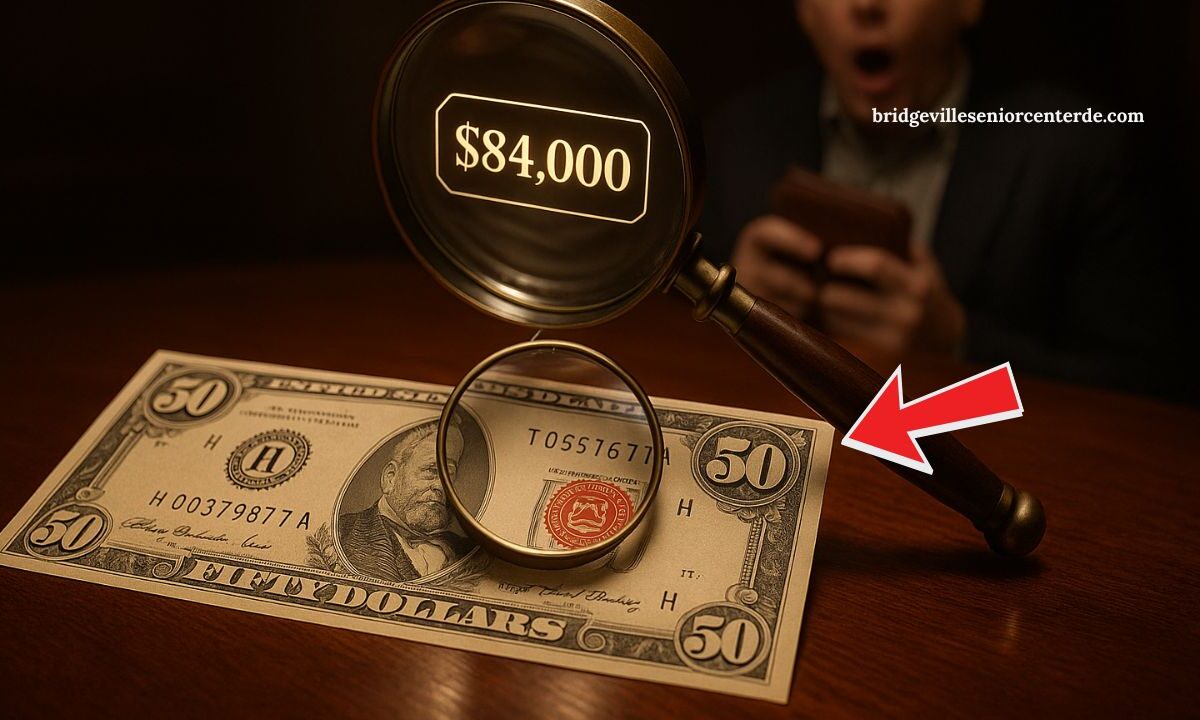Imagine holding a simple $50 bill in your hand—only to discover it’s worth tens of thousands of dollars. That’s the case for one lucky individual who recently sold a rare $50 bill with an upside-down seal for $84,000.
These kinds of printing mistakes, known as inverted seal errors, are extremely rare and highly sought after by currency collectors. With the right eye and a bit of luck, you might just find one hiding in your wallet.
What Is an Upside‑Down Seal Error?
During the final stage of currency production, the Treasury seal and serial numbers are overprinted onto sheets of already printed notes. If these sheets are inserted incorrectly, the seal may be printed upside-down—while the rest of the bill appears normal.
These misprints are known as inverted overprint errors, and while rare, they do occasionally make it past quality control.
What makes these notes unique:
- The portrait is correctly aligned, but the green Treasury seal and serial numbers are flipped.
- These notes are not easily faked, thanks to specific ink, paper, and serial number tracking.
- Most were likely printed in the early 2000s but could exist in other series.
How Much Are These Bills Worth?
The recent sale of one of these upside-down seal $50 bills for $84,000 has shocked even seasoned collectors. These error notes often fetch thousands to tens of thousands of dollars, depending on their condition and rarity.
Value Range by Condition:
| Condition | Estimated Value |
|---|---|
| Circulated | $1,500 – $8,000 |
| Extra Fine | $10,000 – $30,000 |
| Uncirculated | $50,000 – $84,000+ |
Uncirculated bills with strong visual appeal and a clear inverted seal are considered top-tier collectibles.
How to Spot an Upside‑Down Seal $50 Bill
Here’s how to check if your $50 bill might be worth a fortune:
- Look at the front of the bill. Focus on the green Treasury seal and serial numbers.
- Check their orientation. Are they flipped while the rest of the bill looks normal?
- Compare with a standard $50 bill. Place them side-by-side for easier identification.
- Inspect the series year. Many of the known error notes come from series like 2004 and 2004A.
No special tools are required—this error is easily visible to the naked eye, making it one of the most recognizable printing mistakes in U.S. currency.
What to Do If You Find One
If you suspect that you’ve found an upside-down seal $50 bill, take these steps:
- Do not spend it. Once it’s in circulation, recovering it or proving authenticity may be difficult.
- Protect the bill. Store it in a plastic sleeve or currency holder to preserve its condition.
- Get it authenticated. Submit it to a recognized currency grading service such as PMG or PCGS.
- Consult a currency dealer or auction house. They can assess value and connect you with collectors.
Proper documentation and authentication significantly boost the resale value of rare currency.
Why Collectors Love Error Bills
Currency error notes like the upside-down seal bill are highly collectible for several reasons:
- Scarcity: Very few are known to exist.
- Visual Impact: The error is bold and obvious, unlike subtle defects.
- Historical Relevance: Errors serve as tangible proof of how even high-security systems can fail.
- Investment Potential: Rare currency continues to gain value over time, especially as more collectors enter the market.
It’s not just about the money—collecting rare bills is also about history, curiosity, and the thrill of the hunt.
Could There Be More Out There?
Yes—many of these bills are believed to have entered regular circulation. People might unknowingly spend them at stores, deposit them at banks, or forget about them in drawers. That’s why it’s worth examining every $50 bill you handle, especially older ones.
You never know when you’ll come across a forgotten gem.
| Feature | Details |
|---|---|
| Error Type | Upside-down Treasury seal |
| Common Denomination | $50 bill |
| Value Range | $1,500 – $84,000+ |
| Highest Known Sale | $84,000 |
| Key Identification Tip | Seal is flipped; portrait remains upright |
| Authentication Required | Yes – via professional grading services |
| Ideal Condition | Uncirculated or crisp bills |
A simple printing error turned one $50 bill into an $84,000 windfall—and yours could be next. These rare notes are more than mistakes; they’re collectibles with real market value.
Whether you’re a seasoned collector or someone who uses cash daily, it’s worth taking a second look at the bills in your wallet.
FAQs
Is an upside-down seal on any bill worth money?
Yes, especially on higher denominations like $50. The value depends on the bill’s condition and the visibility of the error.
Can I sell an error bill without certification?
While it’s possible, getting your bill authenticated by a reputable grading service will likely increase your chances of a higher sale price.
Should I notify a bank or the government if I find one?
No. These are legitimate U.S. bills that simply contain printing errors. You can keep or sell them legally.
